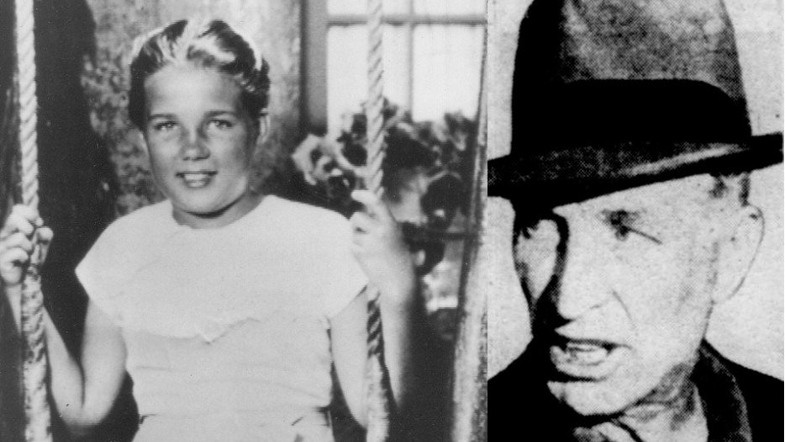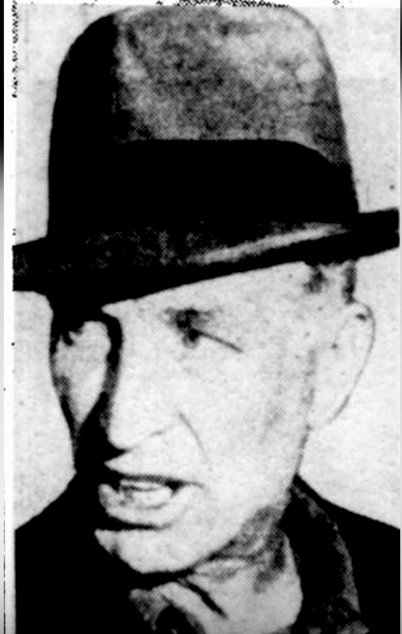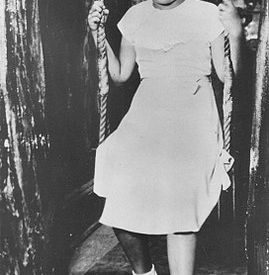In 1948, 11-year-old Sally Horner was kidnapped and held hostage for two years as her kidnapper drove her around the United States
By Noelle Talmon

Russian-American novelist Vladimir Nabokov wrote the novel Lolita in 1955. Narrated by a middle-aged man named Humbert Humbert, the book tells the story of his obsession with a 12-year-old girl named Dolores Haze (Lolita) and the sexual relationship he forces her into. In the novel, Dolores eventually escapes Humbert, who has an emotional breakdown. In time, when they next see each other, Dolores is pregnant but suffering financially. Despite her difficult circumstances, she has overcome her past and made a life for herself. There?s a glimpse of a better future.
Florence ?Sally? Horner was abducted in 1948 by a man who repeatedly sexually assaulted her for two years. She was finally rescued only to be victim-blamed by the media, and she died tragically two years later ? at age 15. Unlike Dolores, Sally Horner wasn?t given the time to move on from the trauma she experienced as an adolescent.
Sally?s story and Lolita have a lot in common. They took place in nearly the exact same year, and the girls were nearly the same age, with single mothers. However, beyond the narrative similarities between Sally Horner?s captivity and Lolita, Nabokov also had numerous newspaper clippings of the event, so he was clearly reading about and inspired by it. Even so, scholars didn?t make the connection between the book and the history until more than 50 years following publication.
A Shoplifting Incident Changed Sally Horner?s Life Forever
 Source: Wikimedia Commons
Source: Wikimedia Commons
On June 13, 1948, just before her fifth-grade graduation, 11-year-old Sally Horner tried to steal a five-cent notebook from a Woolworth?s in Camden, New Jersey. The crime was part of an initiation into a girls? club at her school, and although this would be the first time she?d attempted to steal anything, she was willing to do it to be part of the popular crowd. Her classmates insisted that it would be simple, and she wouldn?t get caught.
However, Sally, an inexperienced thief, didn?t get away free and clear. A man spotted her trying to steal the notebook and grabbed her by the arm as she tried to flee the store; he then told her he was an FBI agent. She was terrified of the man, who began spinning a web of lies about the law that Sally had no reason not to believe. To her relief, he told her that he wouldn?t take her to jail, but that she would need to check in with him from then on. Presumably, this was because he was doing her a big favor by letting her go. Thankful, she returned home to her mother, only to be intercepted by the man the next day.
Sally?s Home Life Was Not Always Easy
When the purported FBI agent first let Sally go after the notebook incident, she was extremely relieved. She didn?t know what would have happened if she had been arrested. Her mother, Ella, worked hard as a seamstress to make ends meet. Her father, who had been an alcoholic, had committed suicide when she was just six years old, so Ella was a single mother. Meanwhile, Sally?s older sister, Susan, was pregnant. An arrest would have made things very difficult for her already struggling family.
The Man, Frank LaSalle, Tricked Her Into Going To Atlantic City
 Source: Wikimedia Commons
Source: Wikimedia Commons
Sally?s relief at not being arrested for the notebook shoplifting incident didn?t last long. The man had clearly followed her, and after school the next day, he intercepted her. He told her his name was Frank LaSalle, and he convinced the young girl that she should be thankful that it was he who caught her stealing. To properly express her gratitude, he said, she had to obey his demands, which included going with him to Atlantic City. LaSalle explained that the government needed her to go with him, and if she refused, she would be sent to reform school. Sally lied to her mother, explaining that she was taking a beach trip with a classmate and her father.
In reality, LaSalle was no FBI agent; he was a 50-year-old mechanic who had already served a prison sentence for statutory rape among other egregious crimes. Prior to meeting Sally, he?d been convicted of rape and arrested for bigamy, indecent assault, and enticing minors. Other media reports claimed he had a history of child molestation.
LaSalle had also been married before he abducted Sally. He?d met his wife, Dorothy Dare, when she was only 17 years old and a recent high school graduate. LaSalle was then using an assumed name and age, and was more than twice Dorothy?s age. But Dorothy felt constrained by her father?s strict rules, and eagerly ran off with LaSalle. Dorothy?s father was upset that his daughter, a minor, was dating an older man and secured warrants against LaSalle. He was arrested under the pseudonym Frank Fogg in Pennsylvania but released after producing a legal marriage certificate to Dorothy. They even had a child together, but eventually Dorothy sued him for neglect and lack of support. LaSalle, it turned out, was out preying on other young girls, but it?s unconfirmed if Dorothy was aware of this.
LaSalle Posed As Sally?s Father And Moved Her From Atlantic City To Maryland To Texas
Atlantic City was not a far drive from Camden, where Sally had grown up. She and LaSalle spent six weeks in Atlantic City, while her mother still believed she was vacationing with a schoolmate. Then LaSalle took her to Baltimore, Maryland. At first, they were accompanied by a young woman in her 20s whom LaSalle called Miss Robinson. He claimed she was his secretary. Miss Robinson left shortly afterwards, and he and Sally moved to Dallas, Texas. Sally continued to stay with LaSalle, still believing he would turn her in to authorities for the notebook theft. According to a Washington Post article from the time, Sally pretended to be his daughter and even attended parochial schools in Baltimore and Dallas.
A Neighbor Helped To Rescue Sally
While they were living in a trailer park in Dallas, their neighbor Ruth Janish noticed something amiss between LaSalle and his ?daughter? Sally. She tried talking to the young girl, but Sally was afraid to reveal anything. Janish?s intuition, however, remained.
When Janish and her husband later moved to San Jose, California, Janish hatched a plan to fish more information out of Sally. She wrote a letter to LaSalle, recommending he relocate to San Jose, too, because there were a lot of work opportunities. LaSalle agreed, and in March of 1950, he and Sally drove LaSalle?s mobile home to San Jose. Leaving the car hitched to the trailer, LaSalle took the bus into the city to look for work, leaving Sally alone. Janish coerced the girl into coming over to her trailer and opening up a little more, even offering her the phone to call her family members. Although no one picked up at her mother?s home, Sally called her sister Susan, whose husband contacted the FBI. Sally was removed from LaSalle?s home before he returned from his job hunt.
LaSalle Insisted Sally Was His Daughter During His Trial
 Source: YouTube
Source: YouTube
By the time Sally was rescued by authorities, she had spent nearly two years in captivity. She revealed to her rescuers that LaSalle repeatedly raped her. LaSalle was arrested as he arrived back at the trailer park from his day of job hunting. He was then sent to trial, during which he wouldn?t budge from his claim that Sally was his daughter. In fact, Sally was forced to make a statement that LaSalle was not her father. She said: ?My real daddy died when I was six and I remember what he looks like. I never saw this man before that day at the dime store.? He pled guilty, and received 30 to 35 years at Trenton State Prison. LaSalle died in lockup in 1966 at the age of 70 from arteriosclerosis.
After Her Rescue, Tragedy Continued To Follow Sally
While the newspapers in 13-year-old Sally?s hometown of Camden tended to paint a sympathetic portrait of the young girl?s abduction, much of the media also engaged in its share of victim blaming, pointing out that Sally wouldn?t have been so vulnerable if she hadn?t shoplifted. The Associated Press described her as ?chubby? and other papers called her plump and husky, even though she was 110 pounds and 5-feet tall. They also published her name, which happens rarely nowadays in cases involving minors and sexual crimes. Some outlets even included the times and places LaSalle had assaulted Sally.
Sally struggled to return to ordinary life following her two years of sexual captivity. In the 1950s, there was little research about the effects of such a traumatic experience on adolescents, so her treatment was likely inadequate. She was rescued in the spring of 1950, but she died two years later in a car accident at just 15. In a twisted show of support, LaSalle sent Sally?s family flowers for the funeral. They refused to accept them. It was the only time LaSalle attempted to reach out to Sally?s family following his trial.
Lolita Mentions The Sally Horner Case Specifically, But Historians Didn?t See The Connection For Decades
 Source: Wikimedia Commons
Source: Wikimedia Commons
Nabokov originally wrote what would become Lolita as a short story in Russian, but several years after moving to the United States, he decided to re-work it as a novel in English. Despite having a journal full of clippings about the Sally Horner case ? and even referencing her story directly in the novel ? no one really followed up on making the connection between Nabokov?s work of fiction and the real-life tragedy of Sally Horner.


